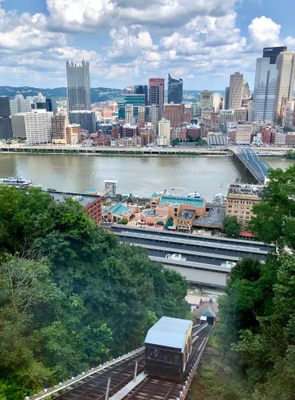About
Pittsburgh’s neighborhoods south of the Monongahela River have the most spectacular views. Looking north to the downtown skyline, where the Ohio, Allegheny, and Monongahela Rivers all join forces, it’s easy to see why the city’s earliest developers would want to build there. But that’s not what happened.
In the early days, it was primarily coal and steel workers who lived up there, many of whom were German immigrants, and they had to struggle along rutted switchbacks to commute to and from their jobs down below. The workers who lived up top scrambled down the muddy footpaths to the industrial river flats down below, and scrambled back up again at the end of the day. It was a tough climb, but once you got there, the view was unparalleled.
It was these immigrants, dreaming of the inclines (or funiculars as they are also known) back in Europe who first proposed that Pittsburgh do the same thing. Funiculars were common in Germany, and in the latter half of the 19th century they started to pop up (literally) all over. This one, the Monongahela Incline, was built between 1869 and 1870 and is the United States’ oldest continuously operating funicular. Named for the river down below, it was the first one, but three more soon followed in the Mount Washington neighborhood alone. At the height of Pittsburgh’s funicular craze there were 17 such little railways, spread out along the city’s high ridges.
Today, two of the four Mount Washington inclines are still clattering along, whisking commuters and tourists from the top down to the flats, and back up again. In addition to the Monongahela there is also its younger sister, the Duquesne Incline, about a mile away. It’s just a baby though, only going back to 1877.
Related Tags
Know Before You Go
The lower station is one block west from Station Square.
Community Contributors
Added By
Edited By
Published
March 7, 2016


























































